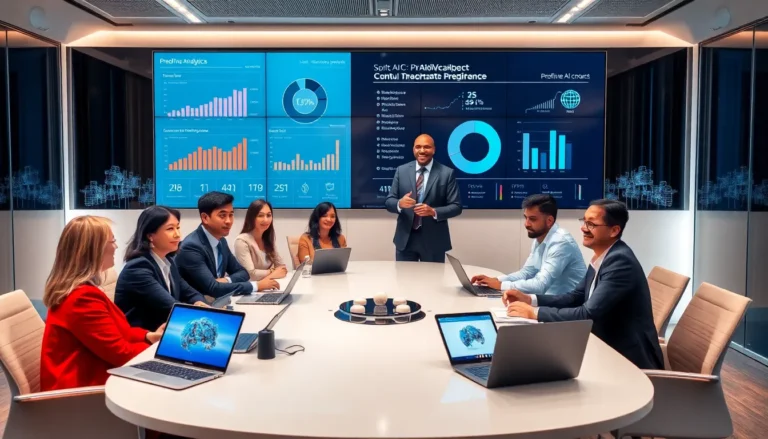Table of Contents
ToggleIn today’s fast-paced digital landscape, businesses are constantly seeking efficient solutions to streamline operations and reduce costs. Multi-tenant Software as a Service (SaaS) has emerged as a game-changing model that allows multiple customers to share a single software instance while keeping their data secure and separate. This approach not only enhances resource utilization but also simplifies updates and maintenance, making it an attractive option for organizations of all sizes.
As companies embrace cloud technology, understanding the intricacies of multi-tenant SaaS becomes essential. This model offers scalability and flexibility, catering to diverse business needs while fostering innovation. By leveraging this powerful architecture, businesses can focus on growth and customer satisfaction, all while enjoying the benefits of reduced IT overhead. Dive into the world of multi-tenant SaaS to discover how it can transform operations and drive success.
Overview of Multi-Tenant SaaS
Multi-tenant SaaS architecture allows multiple customers to access a single software instance, utilizing a shared computing environment. This model ensures data remains isolated and secure, with each customer’s information protected against unauthorized access.
Key characteristics of multi-tenant SaaS include:
- Cost Efficiency: Businesses benefit from reduced upfront costs and lower maintenance expenses due to shared resources.
- Scalability: Companies can quickly scale their usage to meet demand without significant infrastructure investments.
- Automatic Updates: Providers manage updates centrally, ensuring all tenants receive the latest features and security enhancements simultaneously.
- Resource Optimization: Cloud resources, such as servers and storage, are utilized more effectively, accommodating varying workloads across tenants.
Organizations adopting multi-tenant SaaS gain flexibility and support innovation by easily integrating new functionalities. By leveraging this approach, businesses can focus on their core activities while enjoying a reliable and manageable software solution.
Key Features of Multi-Tenant SaaS

Multi-tenant SaaS offers several advantages that benefit organizations of varying sizes. Understanding its key features helps businesses make informed decisions regarding their software deployment.
Scalability
Scalability in multi-tenant SaaS allows organizations to adjust their usage based on demand. Companies can increase or decrease their subscription levels without needing extensive downtime or additional infrastructure. This flexibility accommodates growth quickly, helping businesses manage seasonal fluctuations or unexpected demands. With multi-tenant architecture, resources are allocated efficiently, enabling seamless transitions as businesses evolve.
Cost Efficiency
Cost efficiency is a defining characteristic of multi-tenant SaaS. The shared environment allows multiple organizations to use the same resources, significantly reducing the costs associated with software ownership. Companies avoid hefty capital expenditures typically linked to on-premises solutions. Instead, they benefit from a subscription model that encompasses maintenance, updates, and security, leading to predictable budgeting. This cost-effective approach allows organizations to divert funds to other areas while still accessing top-tier software functionality.
Benefits of Multi-Tenant SaaS
Multi-tenant SaaS offers several advantages that enhance operational efficiency and effectiveness. The collaborative environment and improved security make it a compelling choice for businesses.
Enhanced Collaboration
Enhanced collaboration is a significant benefit of multi-tenant SaaS. Multiple users can access shared software from various locations, promoting teamwork regardless of geographical barriers. Tools integrated within the platform allow real-time communication, file sharing, and project management, helping teams stay aligned and productive. For example, features like shared dashboards and collaborative document editing enable seamless workflows. Organizations can foster innovation and agility by utilizing these collaborative capabilities.
Improved Security
Improved security is critical in multi-tenant SaaS environments. Providers implement robust security measures, such as data encryption, multi-factor authentication, and regular security audits, to protect customer data. Each tenant’s data remains isolated, reducing risks associated with data breaches. SaaS providers also stay up-to-date with compliance standards and regulations, ensuring that all tenants benefit from the latest security enhancements. This level of security proves vital, particularly for industries handling sensitive information, allowing businesses to operate confidently in a shared infrastructure.
Challenges of Multi-Tenant SaaS
Multi-tenant SaaS introduces several challenges that organizations must address to ensure seamless operations and service delivery. Two significant challenges include data isolation concerns and performance issues.
Data Isolation Concerns
Data isolation remains a primary concern in multi-tenant SaaS models. Given that multiple clients share the same database, ensuring that one tenant’s data remains secure and inaccessible to others is critical. Breaches can lead to unauthorized access, risking sensitive information. To mitigate these risks, providers implement stringent security measures, such as encryption and access controls. Moreover, regular audits and compliance checks help maintain data integrity and foster trust among clients.
Performance Issues
Performance issues can arise as the number of tenants increases within a multi-tenant solution. High traffic from numerous users can strain shared resources, leading to latency and slower response times. Organizations may experience degraded performance, especially during peak usage periods. To combat these challenges, providers often utilize load balancing and resource allocation strategies. Implementing robust infrastructure and autoscaling mechanisms can enhance performance by dynamically adjusting resources based on demand, ensuring a responsive experience for all users.
Multi-tenant SaaS stands out as a powerful solution for businesses seeking efficiency and flexibility in their software management. By allowing multiple users to operate within a shared environment, it not only reduces costs but also enhances collaboration and security. The ability to scale effortlessly and access the latest features ensures that organizations can adapt to changing demands without significant investment.
While challenges like data isolation and performance issues exist, they can be effectively managed through robust security measures and infrastructure strategies. As companies continue to embrace cloud technology, understanding and leveraging multi-tenant SaaS can drive innovation and streamline operations, ultimately leading to improved customer satisfaction and business growth.





